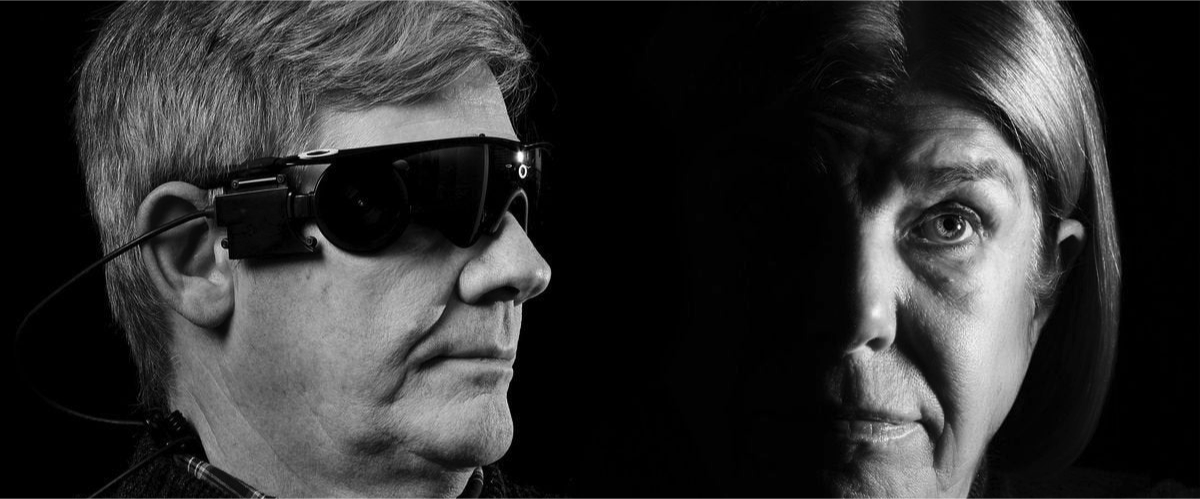THEIR BIONIC EYES ARE NOW OBSOLETE AND UNSUPPORTED
By Eliza Strickland and Mark Harris
BARBARA CAMPBELL was walking through a New York City subway station during rush hour when her world abruptly went dark. For four years, Campbell had been using a high-tech implant in her left eye that gave her a crude kind of bionic vision, partially compensating for the genetic disease that had rendered her completely blind in her 30s. “I remember exactly where I was: I was switching from the 6 train to the F train,” Campbell tells IEEE Spectrum. “I was about to go down the stairs, and all of a sudden I heard a little ‘beep, beep, beep’ sound.”
It wasn’t her phone battery running out. It was her Argus II retinal implant system powering down. The patches of light and dark that she’d been able to see with the implant’s help vanished.
Terry Byland is the only person to have received this kind of implant in both eyes. He got the first-generation Argus I implant, made by the company Second Sight Medical Products, in his right eye in 2004 and the subsequent Argus II implant in his left 11 years later. He helped the company test the technology, spoke to the press movingly about his experiences, and even met Stevie Wonder at a conference. “[I] went from being just a person that was doing the testing to being a spokesman,” he remembers.
Yet in 2020, Byland had to find out secondhand that the company had abandoned the technology and was on the verge of going bankrupt. While his two-implant system is still working, he doesn’t know how long that will be the case. “As long as nothing goes wrong, I’m fine,” he says. “But if something does go wrong with it, well, I’m screwed. Because there’s no way of getting it fixed.”
Ross Doerr, another Second Sight patient, doesn’t mince words: “It is fantastic technology and a lousy company,” he says. He received an implant in one eye in 2019 and remembers seeing the shining lights of Christmas trees that holiday season. He was thrilled to learn in early 2020 that he was eligible for software upgrades that could further improve his vision. Yet in the early months of the COVID-19 pandemic, he heard troubling rumors about the company and called his Second Sight vision-rehab therapist. “She said, ‘Well, funny you should call. We all just got laid off,’ ” he remembers. “She said, ‘By the way, you’re not getting your upgrades.’ ”
These three patients, and more than 350 other blind people around the world with Second Sight’s implants in their eyes, find themselves in a world in which the technology that transformed their lives is just another obsolete gadget. One technical hiccup, one broken wire, and they lose their artificial vision, possibly forever. To add injury to insult: A defunct Argus system in the eye could cause medical complications or interfere with procedures such as MRI scans, and it could be painful or expensive to remove.
The company’s current leadership declined to be interviewed for this article but did provide an emailed statement prior to the merger announcement. It said, in part: “We are a recognized global leader in neuromodulation devices for blindness and are committed to developing new technologies to treat the broadest population of sight-impaired individuals.”
Spectrum pieced together Second Sight’s story by interviewing half a dozen patients, a company cofounder, and eight doctors or researchers involved with the company. In their telling, the company took hundreds of patients on a roller-coaster ride of technological innovations, regulatory successes, medical and financial setbacks, and a near-total meltdown. Now, as the company fades away, the future of high-tech vision implants seems blurrier than ever.
Second Sight began with a flash of light. In 1991, Robert Greenberg, an electrical engineer turned medical student, stood in an operating room watching as a retinal surgeon inserted a tiny wire into the eye of a blind patient, who was awake and under local anesthesia. When the wire touched the patient’s retina and delivered a minuscule jolt of electric current, the man reported a spot of light in his pitch-black field of vision. The surgeon inserted a second wire, and the man saw two spots of light. “If you can create two spots, it seemed obvious to me that you could do a lot of spots and create images,” Greenberg said in a 2011 interview for a Spectrum article. “We just needed to build a device.”
Of course, it wasn’t that easy. Greenberg spent many years developing the technology while working at the Alfred Mann Foundation, a nonprofit organization that develops biomedical devices; he spun off the company Second Sight with three cofounders in 1998. The clinical trials of the first-generation Argus I (with a 16-electrode array) and the subsequent Argus II retinal implant (with a 60-pixel array) resulted in European regulatory approval in 2011 and U.S. approval in 2013.
The Argus II system consists of more than just the implant, which is surgically implanted in a procedure that takes about 4 hours. The user also wears special glasses outfitted with a small camera that sends video down a wire to a video processing unit (VPU), typically attached to the user’s belt.
The VPU reduces the images to patterns of 60 black-and-white pixels and sends them back to a transponder in the glasses, which beams them wirelessly to an antenna on the outside of the eye. From there, the signal goes to the 60-electrode array attached to the patient’s retina. The electrodes stimulate the eye in different patterns multiple times per second, creating flashes of light that correspond to the low-resolution video feed. Essentially, the electrodes take the place of the photoreceptor cells in a healthy eye that responds to light and sends information up the optic nerve to the brain.
Normal vision, this is not. Patients and doctors alike stress that the Argus II provides a kind of artificial vision, really a brand-new sense that people must learn how to use. Argus II users perceive shades of gray that appear and disappear as they move their heads. “This was the first of its kind, it was a fledgling technology,” Greenberg told Spectrum in a recent interview. “We asked ourselves a lot: What’s good enough? There’s no doubt that it was very crude.” In its emailed statement, Second Sight says that most patients saw well enough to assist with basic locomotion.
But the company admits that the results varied. While some patients could make out the white stripes of a crosswalk against a dark road or the brightness of a face turned toward them, others struggled to see even basic patterns and shapes. Still, for many, it was worth it. Doerr remembers his attitude before the surgery: “Although it isn’t normal vision, it’s 100 percent better than what I have now.”
Jeroen Perk, who lives in the Netherlands, lost his sight almost completely by the age of 19. In 2013, at the age of 36, Perk became one of the youngest people to receive an Argus II. He was a success story: Within just a couple of years, Perk was shown in Second Sight videos skiing and shooting arrows.
Lucian Del Priore was one of the physicians involved in the clinical trials; he did the implantation for Barbara Campbell while at New York-Presbyterian, in New York City. He remembers the excitement when the U.S. Food and Drug Administration approved the Argus II technology for people with a genetic condition called retinitis pigmentosa and notes that there were no other options for such patients.
“I’m a lucky bastard. I never have any regrets about doing this.” —Jeroen Perk
“These people were completely in the dark,” he says. “They couldn’t tell the difference between a bright day at the beach and being in a coal mine in Pittsburgh. The idea that they were getting some kind of vision, it was kind of electrifying—for the patients and the doctors.”
While the Argus II was technically impressive, it faced financial headwinds. Second Sight was selling the Argus II for around $150,000 in the United States—about five times as much as other neuromodulation devices, according to Greenberg. But even so, he says, the company was losing money: “With all the overhead of sales and regulatory people, it wasn’t profitable.”
Moreover, implanting the Argus II was just the start of a long, tough journey for patients. Second Sight employed its own vision-rehabilitation specialists to work one-on-one with implantees, often for months or years. One Argus II patient estimated that the total cost of the device, surgery and rehabilitation was $497,000. Typically, at least 80 percent of the device fee and most of the other costs were covered by insurance.
A positive outcome was far from certain. Although Linda Kirk was the subject of an optimistic news story on receiving her Argus II in New York in 2017, she found the implant more distracting than enabling. “I really wanted to be able to tell them, this is great; it’s a success. And I couldn’t do that,” she tells Spectrum. Kirk stopped using the device a couple of years later.
At the nonprofit Lighthouse International, a senior fellow in vision science named Aries Arditi was a principal investigator for the Argus II clinical trial. Arditi says his experiences with patients slowly soured him on the technology. He tells Spectrum that in his decades of work with people who were born sighted and later lost their vision, he’s learned that “they often develop a desperate hope for something that will help and are willing to try anything.” Arditi feels that Second Sight promised more than it delivered. “I found it very disturbing that [Second Sight] sold so many of these devices to patients who were relying on hope rather than proven performance.”
Arditi also says that he did a research study including nearly all the U.S. participants in the Argus II clinical trial that showed “weakness” with the device’s visual quality. He says Second Sight wouldn’t let him publish or present the results; the company says it disagreed with his analysis and discouraged him from publishing.
Barbara Campbell, who received her implant during the clinical trial of the Argus II, did find the bionic vision system useful. As a New York City resident, she used it outside on the busy sidewalks and while taking a subway or bus. “The more I used it, the benefits increased,” she remembers. “I think I was retraining my brain to see stuff.” But in 2013, after four years of regular use, Campbell’s system shut down in the subway station, and despite some repair attempts by Second Sight, never worked again. While she talked with her doctors about having the implant removed, she ultimately decided that the risks of another surgery weren’t worth it. She still has the defunct technology in her left eye.
Simply not working isn’t the worst thing that could happen—there’s also the possibility of medical problems. Second Sight conducted an FDA-mandated post-approval study of the Argus II, following 30 patients from 2007 to 2019. Over that time, 36 serious and 152 nonserious “adverse events” were observed. The FDA did not make the study’s final report available to Spectrum, and a Freedom of Information Act request filed in May 2021 has yet to be fulfilled.
However, the FDA also maintains a public database called Manufacturer and User Facility Device Experience, or MAUDE, where manufacturers are required (and health care professionals and patients are encouraged) to submit reports of serious adverse events.
 Spectrum analyzed all 90 MAUDE reports for the Argus II, submitted from 2014 to 2020. These reports are unverified and could be duplicate, biased, inaccurate, or incomplete, warns the FDA. While some described inflammation, infection, or pain that could be managed with medication, nearly 80 percent reported a surgical intervention. The reasons for surgery included hemorrhages, low eye pressure, and, in about 15 percent of cases, detached retinas.
Spectrum analyzed all 90 MAUDE reports for the Argus II, submitted from 2014 to 2020. These reports are unverified and could be duplicate, biased, inaccurate, or incomplete, warns the FDA. While some described inflammation, infection, or pain that could be managed with medication, nearly 80 percent reported a surgical intervention. The reasons for surgery included hemorrhages, low eye pressure, and, in about 15 percent of cases, detached retinas.
To be sure, such outcomes were not very common. Data from 2017 (published in 2020) showed that 83 percent of 244 postapproval patients had experienced no serious events after two years.
“I felt like we were on the verge of really making a big breakthrough.” —Terry Byland
Terry Byland did not encounter any problems with his 2004 Argus I implant. In fact, when Second Sight offered him the Argus II, he was eager to try it. “Once you get a taste of being able to see certain things again, you want to continue on and make it better,” he tells Spectrum. By June 2015, Byland was the only person on the planet with two bionic eyes.
The jump from the Argus I’s 16 electrodes to 60 in the newer technology improved Byland’s vision, and it seemed like more advances were just around the corner. During a series of tests at the University of Southern California and Second Sight in 2016 and 2017, Byland was told about “virtual electrodes,” that is, software upgrades that would boost his system fourfold to around 250 pixels, as well as a new video processing unit. “I was sold,” he says. “I felt like we were on the verge of really making a big breakthrough.”
Other Argus II patients Spectrum spoke with were also told they would be getting upgrades, such as a digital camera, thermal imaging, and even facial recognition software. In 2016, a USC professor even raised the possibility of color vision.
By 2018, Byland’s impressions had shifted. Second Sight continued to ask him to do promotional visits, but testing had slacked off—and there was no sign of any new technology. “It just felt like maybe somebody there wasn’t being completely honest with me,” he says.
Company cofounder Greenberg says Second Sight’s long-term plan was always to pivot to a brain implant that would bypass the eye altogether and directly stimulate the visual cortex. A neural device could help more people with vision problems, even those who weren’t eligible for an Argus II implant because of severe damage to the retina or optic nerve. But Greenberg wasn’t able to steer the company through that transition.
Greenberg’s relationship with Second Sight’s investors had been worsening over the years; he stepped down as CEO in 2015 and then left the board of directors in 2018, a move that he has characterized as a forced departure but that he declined to discuss with Spectrum because of a nondisclosure agreement (NDA).
On 18 July 2019, Second Sight sent Argus patients a letter saying it would be phasing out the retinal implant technology to clear the way for the development of its next-generation brain implant for blindness, Orion, which had begun a clinical trial with six patients the previous year. The U.S. National Institutes of Health is funding that trial as a US$6.4 million project over five years.
“The leadership at the time didn’t believe they could make [the Argus] part of the business profitable,” Greenberg says. “I understood the decision because I think the size of the market turned out to be smaller than we had thought.”
Second Sight was quick to assure Argus patients that its support of their retinal devices would not change. “Second Sight will be maintaining a full team of Customer Care and Vision Rehab Specialists accessible to you as we have in the past,” read the letter. “In addition, we have taken all measures to ensure the ongoing supply needs for your device.”
However, the letter’s promises were already looking shaky, according to one ex-engineer at the company, who asked not to be named because they had also signed an NDA. “We didn’t really support the basic Argus after that,” the engineer tells Spectrum. “We didn’t sell anymore, we didn’t make anymore, we didn’t have anything to do with it anymore.”
And worse was yet to come, for Argus and Orion patients alike.
In February 2020, the senior director of implant R&D left the company, swiftly followed by its CEO. On 30 March, Second Sight laid off the majority of its remaining employees and announced its “intention to wind down operations,” citing the impact of the COVID-19 pandemic on its ability to secure financing. Within weeks, most of its physical assets—including manufacturing equipment, scientific instruments, laptops, and shelving—went up for sale at auction.






